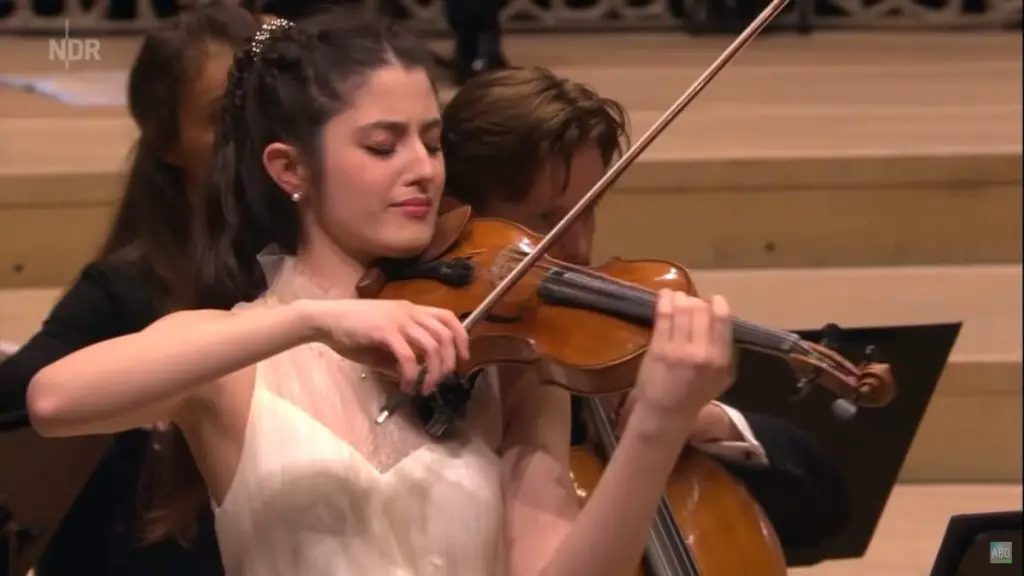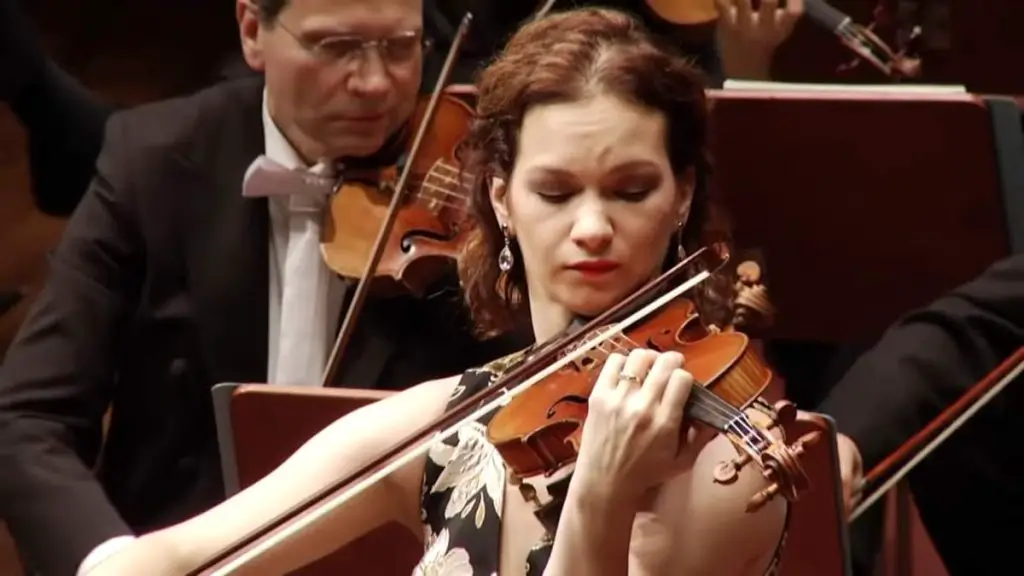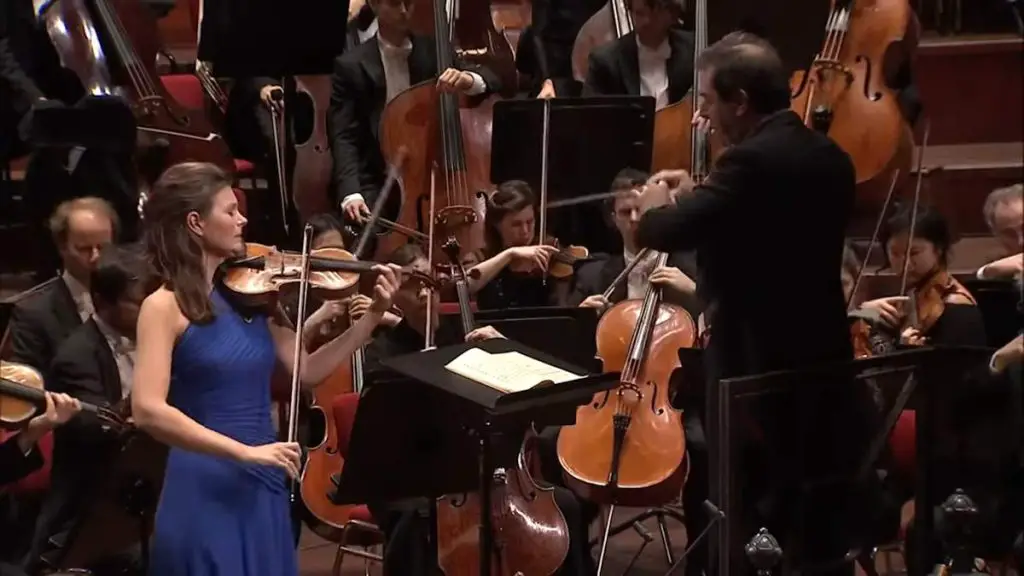Accompanied by the NDR Elbphilharmonie Orchestra, the Spanish violinist María Dueñas performs German Romantic era composer Max Bruch’s (6 January 1838 – 2 October 1920) Violin Concerto No. 1 in G minor, Op. 26, one of the most popular violin concertos in the classical repertoire. Encore: Caprice No. 5 by Niccolò Paganini. Conductor: Manfred Honeck. This performance was recorded on March 25, 2021, at the Elbphilharmonie Hamburg, when María was only 18 years old.
Bruch’s Violin Concerto No. 1
Max Bruch’s Violin Concerto No. 1 in G minor, Op. 26, is one of the most popular and frequently performed violin concertos in the classical repertoire. Composed in 1866, it stands as a shining example of the Romantic era’s musical style, characterized by its emotional depth, lyrical melodies, and virtuosic demands on the soloist.
The concerto is known for its profound expressiveness and the beautiful interplay between the violin and the orchestra. Bruch’s skill in orchestration is evident in how he weaves the solo violin’s part into the rich tapestry of the orchestral accompaniment, allowing for moments of both intimate dialogue and powerful unison. The work is imbued with a sense of Romantic longing, conveyed through its sweeping melodies and dramatic contrasts.
A hallmark of this concerto is the way it showcases the violin’s capabilities, both in terms of technical prowess and expressive potential. The solo violin part is demanding, requiring a high level of skill and emotional depth from the performer. It moves from passages of delicate lyricism to sections of fiery virtuosity, displaying the full range of the instrument’s voice.
Max Bruch’s Violin Concerto No. 1 is beloved not only for its technical brilliance but also for its ability to touch the hearts of listeners. Its enduring popularity is a testament to its emotional resonance and the compelling beauty of its melodies. This concerto remains a favorite among violinists and a staple in the concert repertoire, continuing to captivate audiences worldwide with its blend of lyrical beauty and dramatic intensity.
Program
With start times in the video:
- Vorspiel. Allegro moderato 1:05
- Adagio 9:50
- Finale. Allegro energico 18:45
- Encore: Caprice No. 5 by Niccolò Paganini 26:43
1. Vorspiel. Allegro moderato
The first movement of Max Bruch’s Violin Concerto No. 1 in G minor is a powerful and emotionally charged piece that sets the stage for the entire concerto. It begins with a prelude-like introduction by the orchestra, which establishes the somber and dramatic mood of the movement. This introduction is rich in texture and harmony, creating a sense of anticipation before the solo violin enters.
When the violin makes its entrance, it does so with a sense of lyrical intensity, introducing themes that are both expressive and poignant. Bruch’s writing for the violin is masterful, blending technical virtuosity with deep expressiveness. The soloist navigates through a range of emotions, from moments of introspective melancholy to bursts of passionate intensity.
Throughout the first movement, there is a compelling dialogue between the solo violin and the orchestra. The orchestral accompaniment is intricately woven around the violin’s lines, providing both support and contrast. This interplay highlights the dramatic tension inherent in the music, as well as the emotional depth of the themes.
The movement progresses through a series of developmental sections, where Bruch explores and varies the initial themes. This leads to a climactic section where the soloist showcases their technical abilities, culminating in a powerful and emotionally charged finale.
The first movement of Bruch’s Violin Concerto No. 1 is notable for its combination of dramatic intensity and lyrical beauty. It demands a great deal from the soloist in terms of both technical skill and emotional expression, making it a challenging yet rewarding piece to perform. This movement lays the groundwork for the concerto’s overall narrative, drawing the listener into Bruch’s romantic and expressive musical world.
2. Adagio
The second movement of Max Bruch’s Violin Concerto No. 1 in G minor is the emotional heart of the concerto, known for its lyrical beauty and expressive depth. This movement, typically slower and more reflective than the others, showcases Bruch’s ability to write tender and deeply moving music.
The movement opens with a warm and rich orchestral introduction, setting a mood of introspection and tranquility. The solo violin then enters with a theme that is renowned for its melodic beauty. This theme is both simple and profound, capturing a sense of longing and heartfelt emotion. The violin’s melody is expressive and soulful, allowing the soloist to explore a wide range of dynamics and tonal colors.
Throughout the movement, the interplay between the solo violin and the orchestra is more intimate and nuanced compared to the first movement. The orchestral accompaniment is supportive yet subtle, providing a lush backdrop that enhances the solo violin’s expressive lines. The movement features moments of serene beauty as well as passionate climaxes, creating a rich tapestry of emotional expression.
One of the defining characteristics of this movement is its sense of lyrical flow. The music unfolds gracefully, with the solo violin weaving through the orchestral texture in a way that feels both natural and compelling. This lyrical quality gives the movement a sense of timelessness and universal appeal.
The second movement of Bruch’s Violin Concerto No. 1 concludes with a gentle and reflective coda, bringing the emotional journey of the movement to a serene and satisfying close. This movement is often praised for its emotional resonance and the beauty of its melodic writing, making it a favorite among both violinists and audiences.
3. Finale. Allegro energico
The finale of Max Bruch’s Violin Concerto No. 1 in G minor is a vibrant and energetic finale that contrasts sharply with the introspective and lyrical second movement. Marked as Allegro energico, it bursts forth with a sense of vigor and excitement, showcasing the violin’s virtuosic capabilities.
This movement is characterized by its rhythmic drive and lively tempo. The solo violin part is particularly demanding, featuring rapid passages, brilliant arpeggios, and bold leaps. These technical elements are not just displays of virtuosity; they also contribute to the overall sense of jubilation and exuberance that permeates the movement.
Bruch’s orchestration in this final movement is robust and dynamic, providing a powerful backdrop to the solo violin. The orchestra and soloist engage in a spirited dialogue, with the orchestra often echoing or responding to the violin’s thematic material. This interplay adds to the movement’s energetic and celebratory mood.
The themes introduced in the third movement are catchy and memorable, often featuring folk-like elements that add to the music’s rustic and lively character. These themes are developed and varied throughout the movement, keeping the momentum and interest high.
As the movement progresses, it builds towards a thrilling climax. The soloist’s part becomes increasingly intricate and expressive, leading to a final, exhilarating coda. This coda showcases the soloist’s technical prowess and musicality, bringing the concerto to a triumphant and satisfying conclusion.
María Dueñas
María Dueñas Fernández (born in Granada, on 4 December 2002) is a Spanish violinist and composer. In 2021 she won the first prize in the Yehudi Menuhin Competition, in the senior category. She is considered the Spanish violinist with the greatest international profile, and one of the most promising musicians of her generation. In 2022 she signed an exclusive contract with Deutsche Grammophon.
She enrolled at the Ángel Barrios Conservatory in her native Granada when she was seven. At the age of 11, she won a scholarship from the Juventudes Musicales de Madrid, allowing her to study at the Carl Maria von Weber College of Music in Dresden. She then moved to Vienna to study with Boris Kuschnir and enrolled at the University of Music and Dramatic Art in Vienna and at the University of Graz.

Dueñas has been a soloist with European and American orchestras, such as the San Francisco Symphony, the Luxembourg Philharmonic Orchestra, and the Spanish National Orchestra. In September 2019, Dueñas was designated as the New Artist of the Month by the magazine Musical America, which is the oldest American magazine on classical music.
She won the 1st prize at the 2021 Getting to Carnegie Hall competition, for which each participant performed the world premiere of one movement of Julian Gargiulo’s new sonata for violin and piano. In 2021, at the age of 18, Dueñas won the 1st prize at the Menuhin Competition, and she won the Audience Prize as well. For the competition, Dueñas played Witold Lutosławski’s Subito, Mozart’s Violin Concerto No. 4 in D Major, and Lalo’s Symphonie Espagnole in D minor. The award includes $20,000 and a 2-year loan of a golden period Stradivarius violin.
Dueñas is also a composer and the founder of the Hamamelis Quartett. She composed the piece Farewell when she was 13, which was awarded the Robert Schumann International Piano Competition award in 2016. Her piece was later produced as a music video.
Sources
- Violin Concerto No. 1 (Bruch) on Wikipedia
- “Violin Concerto No. 1 in G Minor, Op. 26, Work by Bruch” on the Encyclopedia Britannica website
- “Bruch – Violin Concerto No. 1 in G minor” on the Classic FM website
- “Max Bruch: Violin Concerto No. 1, in G minor, Op. 26” on the L.A. Phil website
- “Bruch’s Violin Concerto No 1 – a quick guide to the best recordings” on the Gramophone UK website
- María Dueñas on Wikipedia
- María Dueñas’s official website




